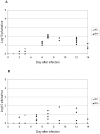Chikungunya virus and Aedes mosquitoes: saliva is infectious as soon as two days after oral infection
- PMID: 19521520
- PMCID: PMC2690823
- DOI: 10.1371/journal.pone.0005895
Chikungunya virus and Aedes mosquitoes: saliva is infectious as soon as two days after oral infection
Abstract
Background: Aedes aegypti and Aedes albopictus are potential vectors of chikungunya virus (CHIKV). The recent CHIKV outbreaks were caused by a new variant characterized by a mutation in the E1 glycoprotein gene (E1-226V) which has favored a better transmissibility by Ae. albopictus. As Ae. albopictus tends to replace Ae. aegypti in many regions, one question remained: is Ae. albopictus as efficient as Ae. aegypti to transmit the variant E1-226V of CHIKV?
Methodology and findings: We infected orally both species with the variant E1-226V and estimated the infection, the viral dissemination, and the transmission rate by real time RT-PCR. Additionally, we used an in vitro assay to determine the amount of virus delivered by mosquitoes in their saliva. We found that Ae. aegypti as well as Ae. albopictus ensured a high replication of the virus which underwent an efficient dissemination as detectable in the salivary glands at day 2 post-infection (pi). Infectious CHIKV particles were delivered by salivary glands from day 2 with a maximum at day 6 pi for Ae. albopictus (10(3.3) PFU) and day 7 pi for Ae. aegypti (10(2.5) PFU).
Conclusions: Ae. albopictus is slightly more efficient than Ae. aegypti to transmit the variant E1-226V of CHIKV. These results will help to design an efficient vector control to limit transmission as soon as the first human cases are diagnosed.
Conflict of interest statement
Figures





References
-
- Renault P, Solet JL, Sissoko D, Balleydier E, Larrieu S, et al. A major epidemic of chikungunya virus infection on Reunion Island, France, 2005–2006. Am J Trop Med Hyg. 2007;77:727–731. - PubMed
-
- Hardy JL, Houk EJ, Kramer LD, Reeves WC. Intrinsic factors affecting vector competence of mosquitoes for arboviruses. Annu Rev Entomol. 1983;28:229–262. - PubMed
Publication types
MeSH terms
Substances
LinkOut - more resources
Full Text Sources
Other Literature Sources
Medical
Research Materials
Miscellaneous

